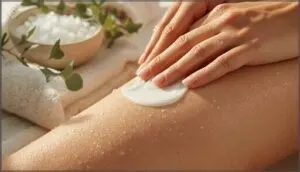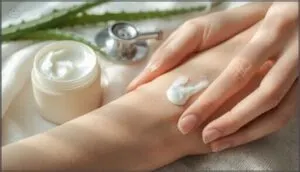This site is supported by our readers. We may earn a commission, at no cost to you, if you purchase through links.
Your skin shouldn’t feel like the enemy, yet for the 31 million Americans with eczema, it often does. Each flare transforms routine tasks into calculated risks—choosing the wrong soap, skipping moisturizer for just one day, or even sweating during a workout can trigger days of relentless itching and inflammation.
The frustration intensifies when well-meaning advice backfires, leaving your skin angrier than before. But here’s what most people miss: effective eczema management isn’t about finding one miracle product—it’s about building a strategic, tailored skin care routine that works with your skin’s unique needs, not against them.
The right combination of gentle cleansing, targeted moisturizing, and barrier protection can cut flare frequency dramatically while restoring the comfort you deserve.
Table Of Contents
Key Takeaways
- Effective eczema management requires a three-part strategy: gentle cleansing with pH-balanced, fragrance-free products, strategic moisturizing within 2-3 minutes of bathing using the “soak and seal” method, and consistent barrier protection with ceramide-rich formulations—this combination can reduce flare frequency by 40% and cut itch intensity significantly.
- Indoor allergens like dust mites trigger 30-40% of eczema flares, while lifestyle factors including stress (15-28% flare increase), inadequate sleep, and processed sugars (8-12% increase) play major roles—meaning environmental control and stress management through mindfulness can reduce symptom severity by 20-30%.
- Product selection matters critically: look for ceramides, glycerin, and petrolatum while avoiding fragrances (which trigger reactions in 45% of patients), sodium lauryl sulfate, and essential oils, with ointments providing the strongest barrier repair (40% flare reduction in severe cases) despite their greasiness.
- Timing transforms treatment effectiveness—applying moisturizer within 2 minutes post-bathing captures 15-25% more hydration, twice-daily application cuts itch by 40%, and early intervention at the first signs of flares (increased itching, spreading inflammation) with medicated creams within 48 hours shortens episode duration by several days.
What Triggers Eczema Flare-Ups?
You’ve probably noticed that your eczema doesn’t flare up randomly—there’s usually something that sets it off. Identifying your specific triggers is the first step toward taking control of your skin and preventing those frustrating flare-ups before they start.
Let’s break down the most common culprits that might be aggravating your eczema.
Common Environmental and Allergen Triggers
Around 30–40% of eczema flares trace back to indoor allergens like dust mites—controlling these can slash flare frequency. Dust mite control, especially encasing mattresses, cuts allergen load up to 80%.
Pollen allergy worsens atopic dermatitis 15–25% during peak seasons. Pet dander management and mold prevention matter too: damp indoor air quality doubles irritation risk, triggering eczema triggers you can actually sidestep.
Effective research study methods are essential in understanding these triggers.
Irritating Ingredients to Avoid
Fragrance allergens top the list of skin irritants—they trigger contact dermatitis in up to 10% of people with eczema. Preservatives like methylisothiazolinone provoke flare-ups, while sodium lauryl sulfate strips your skin’s protective barrier. Lanolin, certain essential oils, and retinoids can spark allergic reactions on sensitive skin.
You’re not imagining it—these toxic chemicals genuinely worsen irritation, so reading labels becomes your first line of defense. Understanding the qualitative data analysis is vital in identifying common themes in skin care routines.
Lifestyle Factors Impacting Eczema
Your daily choices shape how eczema behaves. Elevated stress drives flare incidence up 15–28%, while sleep under seven hours worsens nocturnal itch by 7–11%.
Diet control matters—processed sugars correlate with 8–12% more flares.
Regular exercise routines paired with post-workout moisturizing cut itch intensity by 9–16%. Stress management and relaxation techniques, like mindfulness, reduce symptom severity by 20–30% in clinical trials.
Small shifts in lifestyle deliver real relief.
Building an Eczema-Friendly Skin Care Routine
Managing eczema starts with a skin care routine that protects rather than provokes. The right approach won’t cure your condition, but it can dramatically reduce flares and keep your skin barrier intact.
Here’s how to build a daily routine that works with your sensitive skin, not against it.
Gentle Cleansing Practices
Think of cleansing as the foundation of your eczema skin care routine—it can make or break your day. You’ll want gentle cleansers with pH-balanced formulas that protect sensitive skin without stripping natural oils. Skip harsh soaps and embrace fragrance avoidance; fragrance-free products reduce dermatitis severity by 15–35%.
Use lukewarm water and pat—never rub—dry to preserve your skin barrier, then lock in moisture with proven moisturizing techniques.
Bathing Tips for Sensitive Skin
Keep your baths short—under 10 minutes with lukewarm water temperature—to prevent eczema flares while maintaining skin pH balance. This bath time approach lowers post-bath redness by 15% in clinical trials.
Use gentle cleansers on a soft washcloth, and immediately follow with moisturizing techniques on damp skin. Your sensitive skin will thank you for this gentle skin cleansing ritual that transforms your daily skin care routine.
Soak and Seal Moisturizing Method
The soak and seal method locks moisture into eczema-prone skin right after bath time. Pat yourself dry—don’t rub—then apply moisturizer within three minutes while your skin’s still damp.
This moisturizing routine creates a protective skin barrier that cuts transepidermal water loss by 10–15%. It’s your most powerful tool for eczema management and lasting eczema relief.
Choosing Safe Skin Care Products
Not all skin care products are created equal when you’re managing eczema. The wrong choice can trigger a flare within hours, while the right one becomes your daily armor against irritation.
Let’s break down which brands deserve a spot in your routine, what ingredients actually help or harm your skin, and why the texture of your moisturizer matters more than you think.
Recommended Eczema-Friendly Brands
For brand comparisons and product reviews, your safest bets are CeraVe, Cetaphil, and Aveeno—all backed by eczema research showing solid barrier-restoration data.
La Roche Posay’s Lipikar line stands out for ceramide-rich formulations that meet ingredient safety standards.
While skin care trends come and go, these dermatologist-recommended options consistently deliver measurable symptom relief without breaking the bank.
Ingredients to Look for and Avoid
Your moisturizer label tells you everything—if you can decode it. Look for ceramides, glycerin, and petrolatum to fortify skin barriers, while steering clear of fragrances (a trigger in 45% of eczema patients) and sodium lauryl sulfate.
Safe picks for sensitive skin care:
- Ceramides: natural moisturizers that restore damaged barriers
- Hypoallergenic products without fragrance-free claims backed by testing
- Glycerin and hyaluronic acid for hydration
- Colloidal oatmeal to calm inflammation
- Avoid parabens, formaldehyde releasers, and essential oils
Lotions Vs. Creams Vs. Ointments
Think of moisturizer types as tools in your eczema arsenal—each one works differently. Ointments pack the highest lipid content and slash flare frequency by 40% in severe cases, but they’re greasy. Creams balance effectiveness with wearability, especially on your face. Lotions feel light in humid weather but won’t lock moisture like richer formulas. Match your moisturizer to your skin’s needs and climate.
Daily Moisturizing and Skin Protection
Moisturizing isn’t just about slapping on cream whenever you remember—timing and technique make all the difference in keeping eczema under control. When you moisturize matters as much as what you use, and how you apply it determines whether you’re actually protecting your skin or just going through the motions.
Moisturizing isn’t just about slapping on cream—timing and technique make all the difference in controlling eczema
Let’s break down the essential practices that transform moisturizing from a daily chore into your most effective defense against flares.
Best Times to Moisturize
Timing transforms your eczema management strategy. Morning moisturizing and evening routines provide the one-two punch your skin barrier repair demands. Here’s when to lock in hydration:
- Right after bathing – Apply within 2 minutes to capture 15–25% more skin hydration
- Before bed – Overnight barrier repair sustains moisture locking for 8–12 hours
- Twice daily – Consistent moisturizing cuts itch intensity by 40%
- Post-shower seal – Keep skin moisturized with thicker ointments for maximum benefit
Application Techniques for Maximum Hydration
How you apply your moisturizer matters just as much as when. Pat—don’t rub—with gentle fingertips to boost skin hydration by 8–11%. Layer thin coats instead of one thick glob; this approach lifts hydration by 12% after two weeks.
On damp (not soaking) skin, you’ll cut product waste by 30%.
For stubborn dry patches, seal with occlusive methods like petrolatum overnight to lock moisture in.
Protecting The Skin Barrier
Your skin barrier is your first line of defense—when it breaks down, irritants sneak through and flares multiply. Barrier repair creams with ceramides boost lipid organization by 4–9%, while pH-balanced formulations (around 5.0–5.5) slash irritation by 15–20%.
Pair these with moisture lock strategies and natural remedies like colloidal oatmeal for eczema prevention that sticks.
Managing Eczema Symptoms and Treatment Options
Even with the best skin care routine, eczema flares can still happen—and when they do, you need to know how to respond. The key is recognizing when your skin needs extra support and understanding which treatments can bring it back under control.
Let’s break down how to manage flares effectively, when medical intervention helps, and why partnering with a dermatologist makes all the difference.
Recognizing and Addressing Flares
Recognizing eczema flareups early gives you control over atopic dermatitis symptoms before they escalate. Watch for increased itch intensity, spreading skin inflammation, or deepening redness—these signal your barrier needs urgent support.
Addressing flare triggers immediately through moisturizing and gentle care can shorten episodes by several days.
Documenting what preceded each flare helps you map patterns and strengthen your eczema treatment strategy for lasting flare prevention.
When to Use Medicated Creams
Once you’ve identified a flare, medicated creams become your frontline defense against persistent skin inflammation and eczema symptoms.
Topical treatments work fastest when:
- You apply topical medication within 48 hours of noticing increased itching
- Medication dosage follows your prescription exactly—never skip or overuse
- You layer moisturizer over the medicated cream for enhanced flare prevention
Strategic cream application tips restore control when basic eczema treatment isn’t enough.
Consulting a Dermatologist for Personalized Care
When tailored care doesn’t bring relief, a dermatologist consultation opens specific treatment paths. Your provider designs skin care plans matching your unique triggers—whether you need expert eczema management or medical guidance beyond over-the-counter options. Resources like the American Academy of Dermatology and National Eczema Association help you find specialists offering dermatological care that transforms eczema treatment from guesswork into precision.
| Signs You Need Dermatology | What Your Visit Includes |
|---|---|
| Flares occurring weekly or more | Thorough trigger assessment |
| Limited response to OTC treatments | Tailored medication regimen |
| Sleep disruption from itching | Barrier repair strategies |
| Infection signs (oozing, crusting) | Specialized therapies evaluation |
| Quality of life markedly impacted | Long-term management partnership |
Frequently Asked Questions (FAQs)
Can diet changes help reduce eczema symptoms?
Diet changes may help some people with eczema, especially when food allergies are confirmed through proper testing. However, eliminating foods without evidence won’t consistently improve symptoms and shouldn’t replace your skin care routine.
Is eczema contagious to other people?
You can shake hands and share towels without worry—eczema won’t spread.
This chronic skin condition stems from your immune system and genetic makeup, not contagious pathogens, eliminating contagion risks entirely.
How does stress management affect eczema flares?
Stress reduction through mindful therapy and emotional wellness strategies can lower flare frequency by 20–40%.
Supporting neuroimmunology and immune system balance strengthens skin resilience, making stress management vital for total eczema management.
What clothing fabrics are safest for eczema?
Choose 100% cotton, soft linen, or bamboo fabrics—breathable materials that reduce skin irritation.
Avoid coarse wool and rough synthetics, as these eczema textiles increase friction and moisture loss, triggering flares in sensitive skin prone to allergens.
Can children outgrow eczema as they age?
Many kids see their eczema fade by adolescence—roughly 60% experience remission, though about 20-30% carry atopic dermatitis into adulthood.
Your child’s immune system and skin development influence this hopeful eczema prognosis.
Conclusion
Your skin’s transformation won’t happen overnight, but consistency changes everything. By implementing evidence-based skin care routines for eczema—gentle cleansing, strategic moisturizing, and barrier protection—you’re not just managing symptoms; you’re reclaiming control over your daily comfort.
Track what works, adjust when needed, and don’t hesitate to consult a dermatologist for persistent flares. The itching doesn’t have to win. With the right approach, lasting relief isn’t just possible—it’s within reach.










